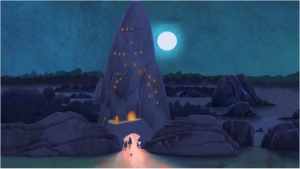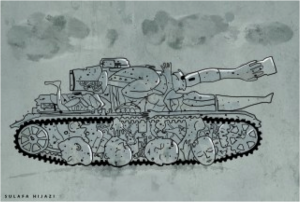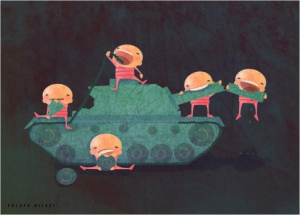In the Middle East, historically, the relationship between art and religion is complex. Islam declares that Allah is the only image-maker, the only creative and shaping being with divine inspiration. In that context, figurative art has been avoided. Islamic art consisted mainly of abstractions, focusing on portraying meaning and essence rather than the physical form of things. Animation adds another layer to the meaning of the creator. Precisely because of its animated nature, animated film takes man as the creator a step further, which is arguably why animation has not always been appreciated in the Middle East.
However, animation is now just as omnipresent in the Middle East as it is in the West, and, as I will argue here, the on-going Revolutions in the region have pushed animators with dissenting voices and styles into the limelight, as they re-assess censorship and find new platforms to express discontent and frustration.
Syria is a special case in the Middle East. Here, a rapid increase in the amount of animation studios in the 1990s seemed out of kilter with the strict censorship regulations of the National Film Organisation. Studios like Blue.Dar, Star Animation, Tiger Productions and ProAction Film, are relatively new but already very influential in the region. At present, however, they are mostly non-active, due overwhelmingly to the Syrian Revolution/Civil War. http://bluedar.net/about.html
In line with the NFO’s close watch on film production, these studios’ mission statements all emphasise a preoccupation with children and family-oriented entertainment, and a consideration of Islamic morals and ethics.
When private companies such as SpaceToons and Blue.Dar (both run by the Hijazi family) started to garner success on a global scale in the early 2000s, the NFO finally became interested. Razam Hijazi’s The Thread of Life (2005) and Sulafa Hijazi’s The Jasmine Birds (2009) were co-produced by Blue.Dar and the NFO. The influence of the NFO ensured the continued educational and didactic nature of the films, avoiding explicit political or social commentary.
As the second feature-length 2D animated film from Syria, The Jasmine Birds tells the story of Ghaith, a jasmine bird who roams the forest with his friend Hatoun, as they search a cure for a mysterious epidemic that plagues their community. Jasmine being the metonym for Damascus, this imaginary bird community is directly linked to a Syrian Arab national identity. In this film, Hijazi tackles universal ideas of life, death and community, with a view to answering questions children ask about human existence. She also – implicitly – criticizes the state, by anthropomorphizing birds who have to deal with the devastation wreaked on a community by disease and distrust.
Jasmine Birds Demo on Youtube:
The Hijazi family is one of the driving forces behind the development of animation in Syria. Sulafa Hijazi, Blue.Dar’s company director, studied theatre, painting and sculpture in Damascus. Since 1997, she has written and directed several television series and other educational and developmental programmes.
Sulafa Hijazi has described her quest as one that searches for an ‘Arab Style’. Her exploration of what that could entail (style of drawing, use of music and settings) can be found here:
https://www.youtube.com/watch?v=kcC0SdL8qh0
She acknowledges the difficulties that come with religious and political censorship but wants to function within such circumstances. She has expressed her frustration at being unable to exercise her freedom of speech, and in an interview with the Doha Film Institute confessed to being ready to let her critical nature infiltrate her animated output (DFI, 2012).
Since the Syrian Revolution started, she has experienced great personal and professional upheaval, while it has also enabled her to move beyond the NFO’s censorship rules. Several of her family members have been arrested, friends have been killed, sometimes simply because they are artists. She has gone into self-imposed exile and now lives in Frankfurt, Germany. It is here that she is now able to practice what she desired: the Revolution has given her an opportunity to become increasingly forceful in her criticism of the Syrian regime, especially in her loathing of the regime’s treatment of its citizens and its children.
This has, naturally, also changed her style of drawing. Whereas before the Revolution she was obliged to work with the NFO and thus made child and family friendly educational materials, both in narrative and in style – in exile she creates entirely different artwork that is both cynical and shocking. Hijazi’s work still revolves around the impact of conflict on children and civilians, and the consequences of excessive exposure to violence, weapons and torture. However, these powerful images are no longer animated, and I wonder whether the stasis of the Revolution is reflected in that. A national censorship and delineation of what animation could contain has turned into a transnational, uncontainable, but for now static, depiction of the grief and suffering of a nation.
Sources
DFI (2012) ‘People in Film: Sulafa Hijazi’ online, available: http://www.dohafilminstitute.com/blog/people-in-film-sulafa-hijazi (accessed 14 April)
Stefanie Van de Peer is Teaching Fellow in Global Cinema at the University of Stirling in Scotland. Her research focuses on women’s filmmaking in the Middle East. She has published articles about women and film in Morocco, Tunisia, Egypt, Syria and Lebanon. She co-edited Art and Trauma in Africa (I.B. Tauris, 2013) with Lizelle Bisschoff and Film Festivals and the Middle East (StAFS, 2014) with Dina Iordanova. She co-directed the Africa in Motion Film Festival until 2011 and has programmed films for the Middle Eastern Film Festival in Edinburgh, REEL Festival in Damascus and Beirut, and the Boston Palestine Film Festival. An edited collection on Animation in the Middle East is forthcoming with I.B. Tauris, 2015.




8 comments for “Animation in the Middle East”